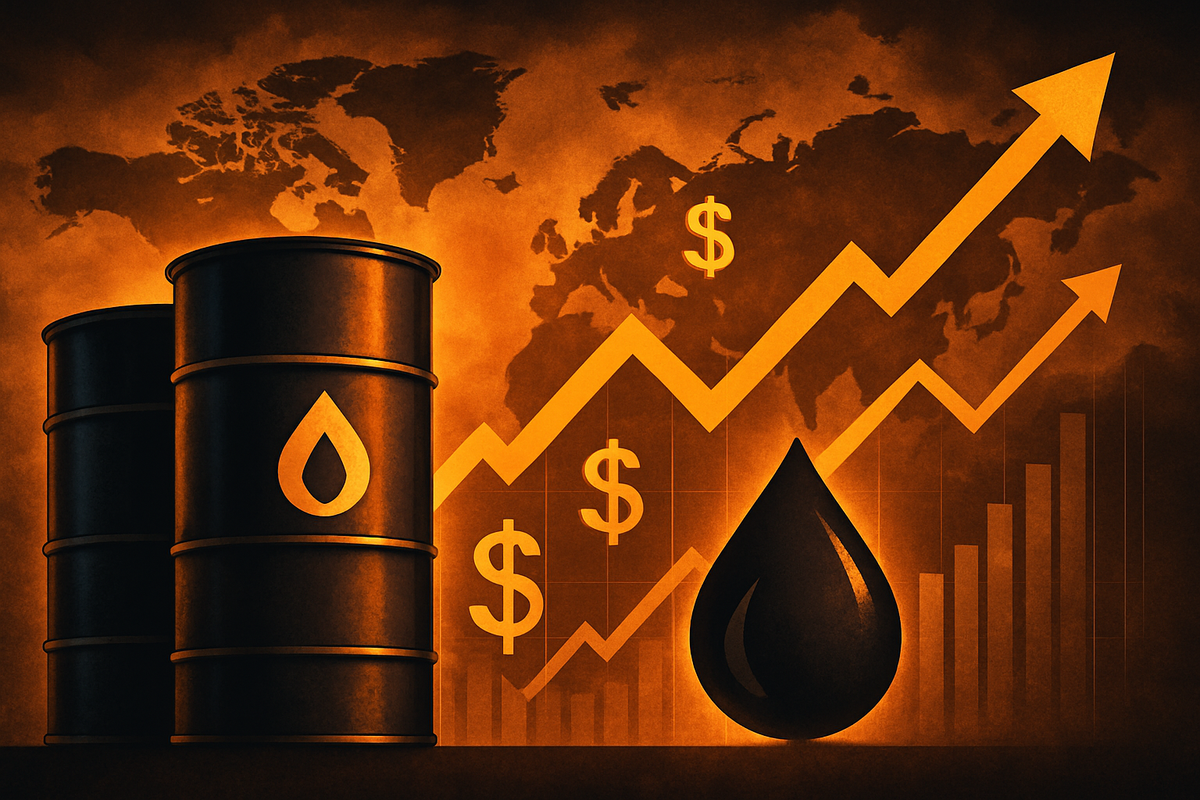
As of October 1, 2025, the global oil market presents a nuanced picture of anticipated oversupply, with Brent crude hovering around $65-$66 per barrel and West Texas Intermediate (WTI) in the low $60s. While the prevailing expert consensus leans towards prices remaining below the triple-digit mark in the immediate future, a significant undercurrent of analysis suggests that a confluence of specific conditions could swiftly propel crude oil to $100 per barrel. This forward-looking analysis delves into the triggers that could unleash such a price surge, exploring the intricate dance between OPEC+ supply management, escalating geopolitical risks, and evolving global demand. A jump to $100 oil would not merely be a symbolic milestone; it would usher in profound economic shifts, challenging central banks, reshaping corporate fortunes, and accelerating the ongoing, albeit uneven, global energy transition.
Unpacking the Path to Triple-Digit Oil: Supply, Demand, and Geopolitics
The journey to $100 oil is predicated on a delicate balance of factors, where any significant disruption could tip the scales. While the current market is characterized by anticipated oversupply, certain scenarios could rapidly tighten the market.
Firstly, significant supply disruptions remain the most potent catalyst. Geopolitical instability in major oil-producing regions is a perennial threat. Recent history illustrates this clearly: Israeli-Iranian clashes in June 2025, for instance, caused Brent crude to spike to $79 per barrel. A more severe escalation, particularly one involving the Strait of Hormuz (a critical chokepoint for 35% of seaborne oil trade), could unilaterally push prices well past $100 per barrel. Infrastructure attacks, such as Ukrainian drone strikes on Russian refineries that have curtailed approximately 500,000 barrels per day (bpd) from global markets, also demonstrate how targeted actions can create immediate deficits.
Secondly, OPEC+ production discipline and decisive cuts are crucial. While OPEC+ has been in a phase of unwinding previous cuts, with planned increases through late 2025, a strategic reversal to more aggressive supply withholding could significantly impact prices. Historically, OPEC+ has implemented substantial cuts, such as removing approximately 5 million bpd from the market from late 2022 to support prices. Saudi Arabia further reduced its output by an additional 1 million bpd in 2023. To push prices towards $100, a much stronger cohesion and deeper cuts would be required, especially as non-OPEC+ production from the United States, Canada, Brazil, and Guyana continues to grow. The alliance's diminishing spare capacity also makes the market more vulnerable to any sudden shocks.
Thirdly, unexpected demand surges could play a role. Despite forecasts for slowing demand growth, a stronger-than-expected global economic performance, especially in key consuming nations like China and India (projected to contribute 400,000-500,000 bpd of demand growth through 2026), could absorb excess supply. A robust rebound in sectors like air travel would also increase jet fuel consumption. While electric vehicles (EVs) are displacing some oil demand, their overall impact on total consumption remains a smaller fraction, with other sectors like diesel and petrochemicals continuing to grow.
Current geopolitical flashpoints, including ongoing tensions in the Middle East and the Russia-Ukraine conflict, continue to cast a shadow of uncertainty. The potential for U.S. sanctions policy to shift, particularly under a new administration, could also reconfigure global oil flows. These unpredictable elements ensure that the specter of $100 oil, though not the base case, remains a tangible possibility.
Corporate Fortunes: Winners and Losers in a $100 Oil World
A sustained jump to $100 per barrel would redistribute wealth across industries, creating clear winners and significant losers among public companies.
On the winning side, oil and gas exploration & production (E&P) companies and integrated oil majors would see a substantial boost. Higher crude prices directly translate to increased revenue and profitability for firms involved in extraction. Companies like ExxonMobil (NYSE: XOM) and Chevron (NYSE: CVX), with their extensive upstream operations, would capitalize on the increased value of their primary product. Independent E&P companies, which are pure plays on oil prices, would also see a direct surge in earnings. Similarly, oilfield services companies such as Halliburton (NYSE: HAL), SLB (formerly Schlumberger), and Baker Hughes (NASDAQ: BKR) would benefit from increased investment in drilling and extraction activities by their E&P clients, leading to higher demand for their equipment and services.
Conversely, industries with high fuel or petrochemical input costs would face immense pressure. Airlines are particularly vulnerable, as jet fuel often constitutes 30-40% of their operating expenses. A jump to $100 oil would significantly erode profit margins for carriers like Delta Air Lines (NYSE: DAL) and United Airlines (NASDAQ: UAL), forcing them to either absorb costs or pass them on through higher fares, potentially dampening demand. Transportation and logistics companies, including trucking and shipping firms, would also grapple with soaring fuel costs, squeezing margins and potentially leading to higher freight charges and slower trade growth.
Chemical companies heavily reliant on petrochemical feedstocks would see their raw material costs skyrocket. Firms manufacturing derivatives of crude oil like benzene or propylene would face margin erosion if they cannot fully pass on these increased costs. Furthermore, consumer discretionary and retail companies would suffer as higher gasoline prices act as a "tax" on household budgets, reducing disposable income and leading to decreased spending on non-essential goods and services. While renewable energy companies might see a long-term competitive advantage as fossil fuels become more expensive, the immediate impact could be mixed, with potential increases in their own supply chain costs and challenges from higher interest rates.
Wider Significance: Economic Ripples, Policy Responses, and Historical Echoes
The implications of $100 oil extend far beyond corporate balance sheets, profoundly impacting global economies, policy decisions, and the trajectory of the energy transition.
Economically, the most immediate and significant ripple effect would be a reacceleration of inflation. Higher crude prices would directly translate into increased costs for transportation, manufacturing, and energy production, leading to "cost-push" inflation across various sectors. This would exert immense pressure on central banks, potentially delaying anticipated interest rate cuts or even forcing further monetary policy tightening to control inflation, thereby risking slower economic growth or even stagflation. Oil-importing nations, including many in Europe, China, and India, would face substantial economic headwinds due dealing with larger import bills.
In terms of policy implications, governments would likely respond with a combination of measures. The U.S. Strategic Petroleum Reserve (SPR) could see further releases to stabilize prices, though its capacity has been drawn down in recent years. Policymakers might also intensify calls for energy independence, encouraging domestic production and accelerated investment in alternative energy sources to insulate their economies from volatile global markets. While true energy independence in a globally interconnected market is complex, the drive to reduce reliance on imported fossil fuels would gain renewed urgency.
The prospect of $100 oil also interacts dynamically with the broader energy transition. On one hand, it makes fossil fuels more expensive, thereby enhancing the economic competitiveness of renewable energy technologies and electric vehicles. This could accelerate consumer adoption of EVs and stimulate investment in clean energy solutions. On the other hand, sustained high oil prices could incentivize increased drilling and production by fossil fuel companies, potentially delaying the full shift away from hydrocarbons in oil-rich nations.
Historically, periods of $100+ oil are not unprecedented. The 1970s oil crises, the 2003-2008 surge (culminating in WTI reaching $147.27), and the 2011-2014 period of high prices (driven by Arab Spring uprisings) all demonstrated the profound impact of energy costs on global stability. The 2022 surge following Russia's invasion of Ukraine further underscored oil's role as a geopolitical weapon and economic lever. While today's context includes the added dimension of a global energy transition, the fundamental challenges of managing inflation, economic growth, and energy security in the face of volatile oil prices remain strikingly similar to past epochs.
What Comes Next: Navigating the Volatile Path Ahead
Should oil prices reach $100 per barrel, the global landscape would undergo significant short-term adjustments and long-term strategic recalibrations.
In the short term, immediate inflationary pressures would be felt across economies, potentially pushing U.S. inflation higher and forcing central banks to delay or reconsider interest rate cuts. Consumer spending would likely contract, particularly in discretionary sectors, as higher fuel costs strain household budgets. Oil-exporting nations would see a surge in revenues, while oil-importing economies would face increased financial burdens.
For governments, strategic pivots would include potential releases from strategic reserves, diplomatic efforts to influence OPEC+ production, and intensified policies to promote energy efficiency and alternative fuels. Companies in the fossil fuel sector would likely ramp up exploration and production to capitalize on increased profitability, potentially leading to a "boom and bust" cycle. Conversely, energy-intensive industries would be forced to adapt through efficiency gains or passing on costs, while renewable energy firms might see a long-term boost in competitiveness despite potential short-term challenges from higher interest rates impacting capital-intensive projects.
Market opportunities would emerge for oil exporters and potentially for investors in the oil and gas sector, which might be seen as undervalued. The enhanced competitiveness of renewables could also foster long-term investment in clean energy technologies. However, challenges would include widespread inflation, reduced global economic growth, and increased market volatility.
Potential scenarios and outcomes range from a stagflationary environment if central banks struggle to balance inflation control with growth, to an accelerated (though potentially uneven) energy transition. Geopolitical realignments could also occur, with oil-producing nations gaining increased economic and political leverage. The role of investment would be dual: higher prices would incentivize further fossil fuel investment in the short term, but they would also underscore the strategic imperative for long-term investment in more stable and domestically sourced renewable energy solutions. The duration and severity of the $100 oil scenario would determine which of these trends ultimately dominates.
Comprehensive Wrap-Up: A Market at the Crossroads
The possibility of oil prices reaching $100 per barrel, while not the current base case for most experts as of October 1, 2025, remains a significant consideration for financial markets and global economies. The key takeaways from this analysis underscore a market at a crossroads, where supply constraints, resilient demand, and persistent geopolitical tensions could quickly converge to drive prices upward.
Should $100 oil materialize, its significance would be profound. It would reignite inflationary pressures, challenging central banks and potentially impacting global economic growth. It would redistribute wealth on a global scale, benefiting oil-exporting nations while straining oil-importing economies. Critically, it would serve as a powerful catalyst for the energy transition, highlighting the vulnerabilities of fossil fuel reliance and accelerating the push towards renewable alternatives, even as it simultaneously incentivizes short-term fossil fuel production. The lasting impact would depend on the duration of such a price surge; a prolonged period of triple-digit oil could fundamentally reshape energy policies, investment landscapes, and consumer behavior for years to come.
For investors, navigating this environment requires vigilance and a balanced perspective. (This content is intended for informational purposes only and is not financial advice). Key factors to watch in the coming months include:
- Geopolitical Developments: Closely monitor conflicts and tensions in the Middle East and Eastern Europe, as these remain the most unpredictable and immediate drivers of oil price volatility.
- OPEC+ Decisions: Pay attention to announcements and actual production levels from the OPEC+ alliance, as their collective strategy is a primary determinant of global supply.
- Global Economic Indicators: Track economic growth forecasts, particularly for major oil consumers like the U.S., China, and India, as robust or weakening demand signals will impact prices.
- Central Bank Communications: Understand the trajectory of interest rates and inflation-fighting measures by central banks, as these will affect overall market conditions and consumer behavior.
- Diversification and Long-term Trends: While energy stocks may offer a hedge against inflation during periods of high oil prices, maintaining a diversified portfolio aligned with your risk tolerance is crucial. Also, consider the long-term implications of the accelerating energy transition and the opportunities it presents in renewable energy and related technologies.
The path of oil prices will continue to be a critical barometer for global economic health and geopolitical stability, demanding careful observation and strategic adaptation from all stakeholders.




